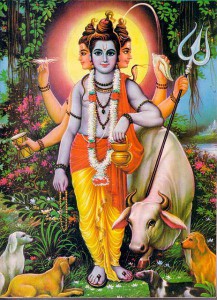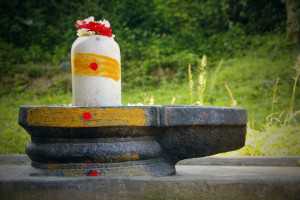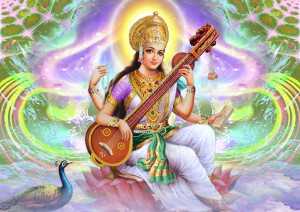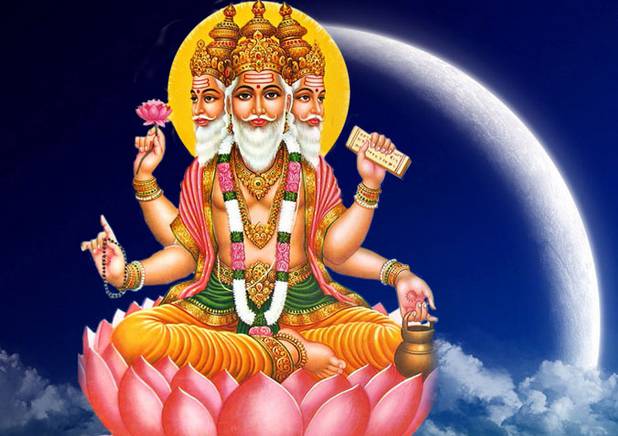No products in the cart.
Lord Brahma is the first member of the Brahmanical triad, Vishnu being the second and Shiva, the third. Brahma is the god of creation and he is traditionally accepted as the Creator of the entire universe.
An individual’s subtle body is constituted of his mind and intellect, that is, his entire thoughts. Man’s subtle body is responsible for the creation of his gross body and also the world that he experiences. The thoughts of an individual determine the type of physical body he possesses. The same thoughts are also responsible for the type of world that the individual experiences around him. As the thoughts, so the world. If a man possesses good thoughts he sees a good world. If his thoughts are bad he sees a bad world. Yudhisthira, a virtuous man saw virtue everywhere, while Duryodhana saw vice everywhere. When thoughts are absent there is no world at all. In deep sleep there are no thoughts, no world. This phenomenon is true not only of the microcosm but of the macrocosm as well. The cosmic subtle body is the aggregate of all subtle bodies of all living beings. The cosmic subtle body called the Hiranyagarbha, is said to be the creator of the entire universe. This creator is Brahma.
The manifested world of plurality has emerged from the Unmanifeset Reality. To indicate this Brahma the creator is described as being born from the navel of Vishnu as he is lying on the great serpent, Ananta in the milky ocean.
Iconography of Lord Brahma
One of the earliest iconographic descriptions of Brahma is that of the four-faced god seated on a lotus. The Lord has in his four hands a water-pot (kamandalu), a manuscript (Vedas), a sacrificial implement (sruva) and a rosary (mala). He wears the hide of a black antelope and his vehicle is a swan (hamsa).
The description of Brahma like those of other deities of Hinduism bears a mystic symbolism. The lotus represents the Reality. Brahma sitting on the lotus indicates that he is ever-rooted in the infinite Reality. Reality is the foundation on which his personality rests. The four faces of Brahma represent the four Vedas. They also symbolize the functioning of the inner personality (antahkarana) which consists of thoughts. They are the mind (manas), the intellect (buddhi), ego (ahamkara) and conditioned-consciousness (chitta). They represent the four ways in which thoughts function. They are the manifestations of the Unmanifeset Consciousness.
The animal hide worn by Brahma stands for austerity. A seeker who desires to realize his godhead must first go through spiritual disciplines. Observing such austerities the seeker must carefully study and reflect upon the scriptural truths which are suggested by the manuscript (Vedas) held in one hand. Having acquired the knowledge of scriptures he must work in the world without ego and egocentric desires, that is engage in dedicated and sacrificial service for the welfare of the world. This idea is suggested by the sacrificial implement held in the second hand. When a man works in the world selflessly he drops his desires. He is no longer extroverted, materialistic, and sensual. His mind is withdrawn from its preoccupations with the world of objects and beings. Such a mind is said to be in uparati. A man who has reached the state of uparati is in a spirit of renunciation.
That is indicated by Brahma holding the kamandalu in his hand. Kamandalu is a water-pot used by a sannyasi-a man of renunciation. It is a symbol of sannyasa or renunciation. The mind of such a man which is withdrawn from the heat of passion of the world is available for deeper concentration and meditation. The rosary (mala) in the fourth hand is meant to be used for chanting and meditation. Meditation is the final gateway to Realization. Through deep and consistent meditation the mind gets annihilated and the seeker attains godhood. A god-man maintains his identity with his supreme Self while he is engaged in the world of perceptions, emotions and thoughts. He retains the concept of unity in diversity. He separates the pure unconditioned consciousness underlying this conditioned world of names and forms. Brahma’s association with a swan is most appropriate in this context.
A swan is described in Hindu mysticism as possessing the unique faculty of separating pure milk from a mixture of milk and water. It is reputed to have the ability to draw the milk alone and leave the water behind. Similarly does a man of Realization move about in the world recognizing the one divinity in the pluralistic phenomena of the world!
Brahma is said to be the Lord of creation. The creator must necessarily possess the knowledge to create. Without knowledge no creation is possible. Hence Brahma is said to be wedded to the goddess of knowledge, Saraswati. Life in this world is a manifestation of the three principles of creation, sustenance and destruction. In fact these three are interconnected. The apparent destruction is only an essential forerunner to creation.
Destruction and creation go hand in hand. They are like two sides of a coin. For example, the destruction of morning is creation of noon and the destruction of noon is creation of night. This chain of continuous destruction and construction maintains the day. Similarly, the destruction of childhood is the creation of youth and the destruction of youth the creation of old age. In this process of birth and death the individual is maintained. Hence the three gods of the Trinity viz. Brahma, Vishnu and Shiva representing creation, maintenance and destruction, are essentially one and the same.
 The above idea is well portrayed in Lord Dattatreya, in whose form the three gods are combined. Dattatreya has the three faces of Brahma, Vishnu and Shiva to indicate that the three principles for which they stand are inseparable. Lord Dattatreya is shown with four dogs following him. The four dogs represent the four Vedas. A dog is one of the most faithful animals in the world and it follows its master in all environments and circumstances. So, too, the Vedas arc said to follow a man-of-Realization in the sense that all his actions, thoughts and desires are in perfect accord with the principles enunciated in the Vedic textbooks.
The above idea is well portrayed in Lord Dattatreya, in whose form the three gods are combined. Dattatreya has the three faces of Brahma, Vishnu and Shiva to indicate that the three principles for which they stand are inseparable. Lord Dattatreya is shown with four dogs following him. The four dogs represent the four Vedas. A dog is one of the most faithful animals in the world and it follows its master in all environments and circumstances. So, too, the Vedas arc said to follow a man-of-Realization in the sense that all his actions, thoughts and desires are in perfect accord with the principles enunciated in the Vedic textbooks.
All creations arise out of vikshepa (thought disturbances). This vikshepa-sakti is Lord Brahma-the total mind-intellect equipment. Man, being essentially constituted of his mind and intellect, has already invoked this vikshepa sakti and realised Brahma. Hence the worship and invocation of Brahma is practiced by few.
Yet there are a few shrines dedicated to Brahma. He is worshiped and invoked particularly by scientists and kings for generating more creative ideas to serve the world of men and matter. The rulers invoke the Lord in order to surrender their ego and produce plans and schemes to serve the nation. Similarly, the research scholars invoke creative inspiration and flashes of new thoughts revealing the secrets of nature.
Lord Brahma is not popularly worshiped in India.
Why is Lord Brahma not popularly worshiped among Hindus?
Curse of Shiva
 According to legends, once Brahma and Vishnu were overcome with the sense of self-importance. They began to argue as to who was the greater of the two. As the argument became heated, Lord Shiva had to intervene. Shiva took the form of a gigantic lingam (the phallic symbol of Shiva). The lingam was made of fire and it extended from the heaven to the underworld. The lingam told both Brahma and Vishnu that if any of them could find the end of the lingam, He will be declared as the greater of the two. Both Brahma and Vishnu agreed to the deal and set out in opposite directions of the lingam to find its end. But as they kept searching for years, they realized that the lingam had no end. Vishnu realized the fact that Shiva was the greatest among the Trinity. But Brahma decided to trick Shiva. While he was on the search of the end, he passed the flower of Ketaki at the uppermost part of the lingam. He requested the Ketaki flower to testify before Shiva that Brahma had reached the uppermost part of the lingam and had seen the end. The Ketaki flower agreed. When brought before Shiva, the flower falsely testified that Brahma had seen the end. Lord Shiva became furious at this lie. He then cursed Brahma that He would never be worshipped by any human being. He also cursed the Ketaki flower that it would not be used in any Hindu ritual. Hence, Brahma was cursed not to be worshiped by anyone.
According to legends, once Brahma and Vishnu were overcome with the sense of self-importance. They began to argue as to who was the greater of the two. As the argument became heated, Lord Shiva had to intervene. Shiva took the form of a gigantic lingam (the phallic symbol of Shiva). The lingam was made of fire and it extended from the heaven to the underworld. The lingam told both Brahma and Vishnu that if any of them could find the end of the lingam, He will be declared as the greater of the two. Both Brahma and Vishnu agreed to the deal and set out in opposite directions of the lingam to find its end. But as they kept searching for years, they realized that the lingam had no end. Vishnu realized the fact that Shiva was the greatest among the Trinity. But Brahma decided to trick Shiva. While he was on the search of the end, he passed the flower of Ketaki at the uppermost part of the lingam. He requested the Ketaki flower to testify before Shiva that Brahma had reached the uppermost part of the lingam and had seen the end. The Ketaki flower agreed. When brought before Shiva, the flower falsely testified that Brahma had seen the end. Lord Shiva became furious at this lie. He then cursed Brahma that He would never be worshipped by any human being. He also cursed the Ketaki flower that it would not be used in any Hindu ritual. Hence, Brahma was cursed not to be worshiped by anyone.
Curse of Saraswati
 According to another legend, after Brahma took birth, he soon created Goddess Saraswati. As soon as He created Her, He became overpowered by the ethereal beauty. But Saraswati did not want to be associated with carnal desire and she changed her forms to escape from Brahma’s sexual overtures. But He did not give up. Finally, unable to control her anger, the Goddess cursed Brahma that He would not be worshipped by any being on Earth. Hence, Brahma is not worshipped in Hinduism in spite of being the Creator. Brahma’s lust signifies the fall of humanity. In Hinduism, it is believed that the basic desires hinders the path to salvation. But the Creator fell prey to the basic desires and so the downfall of humanity was inevitable.
According to another legend, after Brahma took birth, he soon created Goddess Saraswati. As soon as He created Her, He became overpowered by the ethereal beauty. But Saraswati did not want to be associated with carnal desire and she changed her forms to escape from Brahma’s sexual overtures. But He did not give up. Finally, unable to control her anger, the Goddess cursed Brahma that He would not be worshipped by any being on Earth. Hence, Brahma is not worshipped in Hinduism in spite of being the Creator. Brahma’s lust signifies the fall of humanity. In Hinduism, it is believed that the basic desires hinders the path to salvation. But the Creator fell prey to the basic desires and so the downfall of humanity was inevitable.






